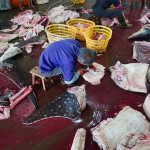CITES is the 1973 Convention on International Trade in Endangered Species, to which 175 nations are signatories. Along with the IUCN Red List, it’s one of the main ways that the international conservation status of a species is recognised (IUCN) and regulated (CITES). The main mechanism for this at CITES is through listing of a species in the “Appendix” of the CITES treaty. Appendix I species are the ones most at risk of going extinct; moving whole or part of any Appendix I species alive or dead across international borders is a big no-no, with rare exceptions for strictly-controlled and permitted scientific research. Appendix II species are less immediately threatened, and international trade in these organisms or any part thereof is regulated by import/export permits from the originating country. You can think of Appendix I species as being in the batters box of exctinction, whereas Appendix II species are just in the on-deck circle…
Periodically the signatories to CITES meet to discuss changes to the Appendices and the next one of these is coming up in Thailand in March 2013. Why this is important right now is that the US government filed a Federal Register Notice yesterday announcing which species they do, and more importantly don’t intend to bring up at that meeting. Here they are:
Species the US will propose:
Nothing marine
Species on which the US is undecided:
Appendix I – porbeagle shark, Lamna nasus; oceanic white tip shark, Carcharhinus longimanus; walrus, Odobenus rosmarus; polar bear, Ursus maritimus
Appendix II – red corals, Corallium sp.; pink corals, Paracorallium sp.; longfin mako shark, Isurus paucus; shortfin mako shark, Isurus oxyrhinchus; porbeagle shark, Lamna nasus; scalloped hammerhead shark, Sphyrna lewini; great hammerhead, S. mokarran; smooth hammerhead, S. zygaena; oceanic white tip shark, Carcharhinus longimanus; thresher sharks, Alopias spp.; orange roughy, Hoplostethus atlanticus; American eel, Anguilla rostrata; walrus, Odobenus rosmarus
Species the US will not propose:
Appendix I – North Atlantic bluefin tuna, Thunnus thynnus; all hammerhead sharks (except those listed above); dusky shark, Carcharhinus obscurus; narwhal, Monodon monoceros
Appendix II – All Nautilus spp.; all gulper sharks, Centrophoridae; all hammerhead sharks (except those listed above); dusky shark, Carcharhinus obscurus; sandbar shark, Carcharhinus plumbeus; Portuguese shark, Centroscymnus coelilepis; spiny dogfish, Squalus acanthias; roundnose grenadier, Coryphaenoides rupestris; roughhead grenadier, Macrourus berglax

So, yeah, that doesn’t read so well. The idea that no marine species at all will be proposed is cognitively dissonant with the avalanche of news and science that says that the oceans and their inhabitants are in imperiled.
But, all is not lost! This list is not finalised. In fact, part of the point of the federal register notice is to provide interested parties with a chance to speak for one or more species. It’s not a simple case of saying loudly “save the dusky shark!”, though, the lobbying must be for those in the “undecided” category (not the “will not propose”) and must based on solidly referenced science. Over the next 6 months, USFWS will be speaking to various scientific and conservation groups about the undecided species listed above, and hopefully some (any? just one? pretty please?) marine species can get moved to the “will propose” column. Another register announcement will come later stating which cases definitely will and wont be made.
What is more disappointing perhaps is the great number of species that will not be proposed by the US, at least not without some earth shattering new science in the next 6 months or so. As we’ve discussed here, emotions run high about some of these, but in most of the cases above, there seems to be enough science to at least not rule them out. Bluefin tuna, narwhals, hammerhead sharks and Nautilus all stand out to me as species that are in clear need of need stricter protections. Unfortunately, the list as it presently reads errs on the side of inaction rather than conservation, which is clearly a missed opportunity. I am sure that they would argue that this represents conservative error – don’t do anything until you are absolutely sure that it’s needed. The problem with that is that proof is an elusive thing in science. To be truly conservative, I would err in the opposite direction: protection until evidence is gathered to suggest that it isn’t needed.
I can’t see that mentality changing anytime soon though, so it looks like we either need to wait on more science, or we have to rely on one of the other signatories to propose them for inclusion. Even then, if the decision is based on the common body of scientific knowledge, the result may be the same.
Read the notice for yourself here.
h/t Bruce Carlson






I’m wondering whether you have any information about whether any of these species are listed as endangered under US law. I’ve been looking into endangered species law a little bit lately, and it seems as though the “critical habitat” requirements make listing of many species (especially marine species) particularly difficult. Many species (80%!) go extinct without ever being listed as endangered!
Regarding the hammerheads, they’re undecided on the great, scalloped, and smooth hammerhead but it probably wouldn’t take much pushing to get them to sign on to a proposal for those species. Great and scalloped hammerheads in particular have gotten some conservation measures rolling for them (FLA’s landing ban, scalloped hammerheads heading towards become a prohibited species nationwide). The only other hammerhead of note in U.S. waters is the bonnethead, which is still pretty abundant. So when they say “all other hammerheads,” for all intents and purposes it really means “bonnetheads.”
It is interesting that the spiny dogfish has gone from potential Appendix II listing to no consideration in two years. A lot of progress has been made in the U.S., but the European population is still pretty dismal.
I can see why duskies wouldn’t be considered for Appendix I, but it’s strange they they’re not at least “undecided” for Appendix II. Weird list from the U.S. this time.
Hi Alexis, I am no expert on this stuff, but USFWS maintains a list page where you can look freshwater species up by state http://www.fws.gov/endangered/ and NMFS has a list page for the marine species http://www.nmfs.noaa.gov/pr/species/esa/
It’s also worth noting that listing under CITES, IUCN and ESA are independent, so for example, just because it’s considered endangered in the US under ESA does not mean that it will be on the IUCN red list, nor listed in a CITES Appendix.
A friend from Australia asked me on Facebook about what’s Australia’s role is in all this. For Aussie readers, here’s the relevant Government website: http://www.environment.gov.au/biodiversity/wildlife-trade/invitecomment/index.html
One of the main reason’s behind why sharks are getting very little attention at CITES is clearly described here. http://www.youtube.com/watch?v=Y3vJxjdktBs&feature=youtu.be
That may be so, but I’m talking about nominations proposed to the US delegation, before it ever even gets to the international CITES animal committee. Those decisions are made at USFWS (freshwater species) and NMFS (marine).
GREAT ARTICLE! I’m hoping to convince the US to propose additional Pacific corals (Scleractinia and Octocorals) in addition to Corallium as the coral curio trade is very alive and well in this country. We’ve seen a staunch increase in the amount of raw coral coming in from Pacific nations of Appendix II species (many of which are current ESA candidates – too bad NMFS is dragging its heals on making a listing decision).
Let me know if you’re ever interested in hearing more about what’s going on down in Florida lately! The Scientific Authority will listen to concerned scientists and promotes MORE SCIENCE in peer-reviewed lit in order to come to a decision on new propositions.
Gary Stokes, thank you for that video, it really explains the reason
Perhaps we should talk. I have been funded now for three trips to assess population numbers of Nautilus. We use BRUVS to ascertain nautilus population numbers. In nine days on Great Barrier Reef, last January, we set three sets of BRUVS at 300m for nine days. We saw about 120 different nautilus. In the Philippines we did the same work and saw 5. This at the place that has seen more Nautilus than any other locality in the world (Bohol Island, perhaps second place in numbers of nautilus caught to nearby Tanon Strait, but maybe not.
So I have the numbers needed now.
Hi Peter, Perhaps you could make a motion to the US CITES delegation for Nautilus protection?